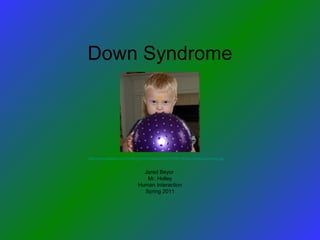Holley project
- 1. Down Syndrome Jared Beyor Mr. Holley Human Interaction Spring 2011 http://www.babble.com/CS/blogs/strollerderby/2007/10/01-07/eric-down-syndrome.jpg
- 2. What is Down Syndrome â A congenital abnormality characterized by moderate to severe mental retardation and a distinctive physical appearance caused by a chromosomal aberration, the result of either an error during embryonic cell division or the inheritance of defective chromosomal materialâ ( Arlene R. Courtney, Ph.D )
- 3. How often does it happen â It occurs in about one in every two hundred conceptions.â (Grace D. Matzen, M.A.; updated by Rebecca Kuzins)
- 4. Symptoms â The slanted appearance of the eyes first reported by Down is caused by a prominent fold of skin called an epicanthic fold (a fold in the upper eyelid near the corner of the eye). This fold of skin is accompanied by excess skin on the back of the neck and abnormal creases in the skin of the palm. In addition, the skull is wide, with a flat back and a flat face. The hair on the skull is sparse and straight.â (Grace D. Matzen, M.A.; updated by Rebecca Kuzins)
- 5. Treatment/Therapy â There is no specific treatment for Down syndromeâ (Grace D. Matzen, M.A.; updated by Rebecca Kuzins)
- 6. How Can I Help Someone With Down Syndrome Volunteer to help take care of a person with down syndrome. http://www.wallpaperhd.org/thumbs/634_2.jpg
- 7. Work Cited http://elibrary.bigchalk.com/elibweb/elib/do/document?set=search&dictionaryClick=on&secondaryNav=&groupid=1&requestid=lib_standard&resultid=1&edition=&ts=D4B0DF6FC5CB27C7509C1540998D0001_1302210913136&start=1&publicationId=&urn=urn%3Abigchalk%3AUS%3BBCLib%3Bdocument%3B161730702 http://health.salempress.com/doi/full/10.3331/Genetics_1132?prevSearch=Down%2BSyndrome&searchHistoryKey=&queryHash=5aced http://www.teenhealthandwellness.com/article/128/2?search=effects%20of%20down%20syndrome http://www.babble.com/CS/blogs/strollerderby/2007/10/01-07/eric-down-syndrome.jpg
- 8. Photo Credits http://www.babble.com/CS/blogs/strollerderby/2007/10/01-07/eric-down-syndrome.jpg http://www.wallpaperhd.org/thumbs/634_2.jpg








